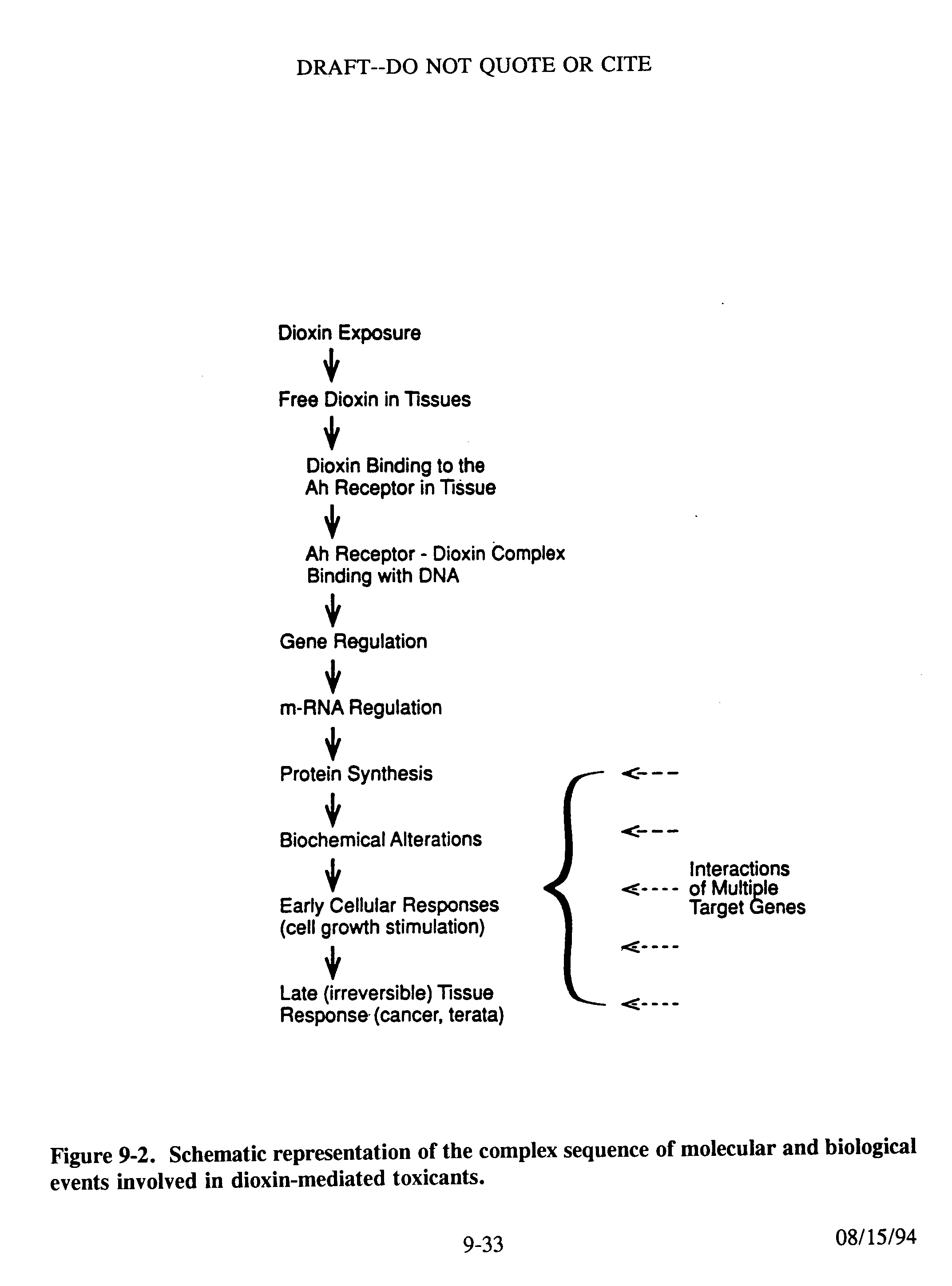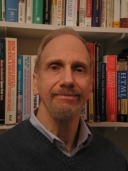The
1994 EPA Dioxin ReassessmentHealth
Assessment, Volume III: Risk Characterization
9.6. MECHANISMS OF DIOXIN ACTION
Knowledge of the mechanisms of dioxin action may facilitate the risk assessment process
by imposing bounds on the assumptions and models used to describe possible responses to
exposure to dioxin. In this document, the relatively extensive data base on dioxin action
has been reviewed, with emphasis on the contribution of the specific cellular receptor for
dioxin and related compounds, the Ah receptor, to the mechanism(s) of action. Other
reviews referenced in Chapter 2 provide additional background on the subject. Discussion
in this chapter will focus on aspects of our understanding of mechanism(s) of dioxin
action that are particularly important in understanding and characterizing dioxin risk,
including:
n Similarities at the biochemical level between humans
and other animals with regard to receptor structure and function;
n Relationship of receptor binding to toxic effects; and
n Role that the purported mechanism(s) of action might
contribute to the diversity of biological response seen in animals and, to some extent, in
humans.
The remarkable potency of TCDD in eliciting its toxic effects in animals suggested the
possible existence of a receptor for dioxin. Biochemical and genetic evidence implicates
the TCDD-receptor in the biological responses to dioxin-like compounds. Electrophoretic
studies to evaluate the properties of specific proteins from inbred mouse strains reveal
the existence of several forms of the TCDD-binding protein. These observations imply the
existence of multiple alleles at the Ah locus in mice. The biochemical properties of the
different forms of the Ah receptor remain to be described. In particular, the extent to
which the different receptor forms affect the sensitivity to TCDD is not known.
Human cells contain an intracellular protein whose properties resemble those of the Ah
receptor in animals. Binding studies and hydrodynamic analyses have identified an Ah
receptor-like protein(s) in a variety of human tissues. Functional Ah receptors have been
found in many human tissues, including lymphocytes, liver, lung, and placenta. By analogy
with the existence of multiple receptor forms in mice, it is reasonable to anticipate that
the human population will also be polymorphic with respect to Ah receptor structure and
function. Therefore, it is also reasonable to expect that humans may differ from one
another in their susceptibilities to TCDD. The binding and hydrodynamic properties of the
Ah receptor differ relatively little across species and tissues yet responses vary widely;
it is impossible, therefore, to account for the diversity of TCDD's biological effects by
characteristics of the receptor alone.
TCDD acts via an intracellular protein (the Ah receptor), which is a ligand-dependent
transcription factor that functions in partnership with a second protein (known as Arnt);
therefore, from a mechanistic standpoint, TCDD's adverse effects appear likely to reflect
sustained alterations in gene expression. Mechanistic studies also indicate that several
proteins contribute to TCDD's gene regulatory effects and that the response to TCDD
probably involves a relatively complex interplay between multiple genetic and
environmental factors. Such mechanistic information imposes constraints on the possible
models that can plausibly account for TCDD's biological effects and, therefore, on the
assumptions used during the risk assessment process. Mechanistic knowledge of dioxin
action may also be useful in other ways. For example, knowledge of genetic polymorphisms
that influence TCDD responsiveness may allow the identification of individuals at
particular risk from exposure to dioxin. In addition, mechanistic knowledge of the
biochemical pathways that are altered by TCDD may identify novel targets for the
development of drugs that can antagonize dioxin's adverse effects.
As described below, biochemical and genetic analyses of the mechanism by which dioxin
induces CYP1A1 gene transcription have revealed the outline of a novel regulatory system
whereby a chemical signal can alter the expression of specific mammalian genes. The
evidence to date implies that the Ah receptor participates in every biological response to
TCDD. For example, studies of structure-activity relationships among congeners of TCDD
reveal a correlation between a compound's specific binding affinity and its potency in
eliciting biochemical responses, such as enzyme induction. Furthermore, inbred mouse
strains in which TCDD binds with lower affinity to the receptor exhibit decreased
sensitivity to dioxin's biological effects, such as thymic involution, cleft palate
formation, and hepatic porphyria. While there are a few investigators who believe that
dioxin may act directly on specific cellular and biological processes without Ah-receptor
mediation, the majority of investigators believe that most, if not all, biological
responses to dioxin and related compounds are Ah-receptor mediated. A simplified diagram
of this hypothesis is presented in Figure 9-2. This hypothesis predicts that TCDD will be
found to activate the transcription of other genes via a receptor- and enhancer-dependent
mechanism analogous to that described for the cytochrome P4501A1 (CYP1A1) gene.
Compensatory changes, which occur in response to TCDD's primary effects, can complicate
the analysis of dioxin action in intact animals. For example, TCDD can produce changes in
the levels of steroid hormones, peptide growth factors, and/or their cognate cellular
receptors. In turn, such alterations have the potential to produce a series of subsequent
biological effects, which are not directly mediated by the Ah receptor. Furthermore, the
hormonal status of an animal appears to influence its susceptibility to the
hepatocarcinogenic effects of TCDD (Lucier et al., 1991). Likewise, exposure to other
chemicals can alter the developmental toxicity of TCDD (Couture et al., 1990). Therefore,
in some cases, TCDD may act in combination with other chemicals to produce its biological
effects. Such phenomena increase the difficulty of analyzing dioxin action in intact
animals

and increase the complexity of risk assessment, given that humans are routinely exposed
to a wide variety of chemicals.
The fact that TCDD may induce a cascade of biochemical changes in the intact animal
raises the possibility that dioxin might produce a response such as cancer by mechanisms
that differ among tissues. These mechanisms are discussed in detail in Chapter 8, along
with the supporting biological data and dose-response models. One possible mechanism
discussed in Chapter 8 is that TCDD might activate a gene(s) that is directly involved in
tissue proliferation. A second mechanism involves TCDD-induced changes in hormone
metabolism, which may lead to tissue proliferation secondary to increased secretion of a
trophic hormone, and/or to changes in metabolism, which might lead to indirect mutagenic
effects. Thus, while this reassessment has identified a number of hypothetical mechanisms
for cancer induction by TCDD, there remains considerable uncertainty about which
mechanisms occur, with what levels of sensitivity, and in which species. Advances in
knowledge regarding the role of such activities in dioxin toxicity will facilitate the
development of more definitive biologically based models of dioxin action.
Under some circumstances, TCDD can protect against the carcinogenic effects of
polycyclic aromatic hydrocarbons in mouse skin; this may reflect the induction of
detoxifying enzymes by dioxin (Cohen et al., 1979; DiGiovanni et al., 1980). In other
situations, TCDD-induced changes in hormone metabolism may alter the growth of
hormone-dependent tumor cells, producing a potential anticarcinogenic effect (Spink et
al., 1990). There is considerable uncertainty about the magnitude and importance of these
effects in relation to both dose and response characteristics of dioxins in various
species. Nonetheless, these (and perhaps other) effects of TCDD complicate the risk
assessment process for dioxin.
A substantial body of biochemical and genetic evidence indicates that the Ah receptor
mediates the biological effects of TCDD. This evidence implies that a response to dioxin
requires the formation of ligand-receptor complexes. TCDD-receptor binding appears to obey
the law of mass action and, therefore, depends on (1) the concentration of ligand in the
target cell; (2) the concentration of receptor in the target cell; and (3) the binding
affinity of the ligand for the receptor. In principle, some TCDD-receptor complexes will
form even at very low levels of dioxin exposure. However, in practice, at some finite
concentration of TCDD, the formation of TCDD-receptor complexes may be insufficient to
elicit detectable effects. Furthermore, biological events subsequent to TCDD-receptor
binding may or may not exhibit a linear response to dioxin. However, recent studies in
several laboratories have indicated no evidence of a threshold for relatively simple
responses to dioxin-like compounds such as CYP1A1 induction and others. Further
information will be required to determine if other responses to dioxin-like compounds
requiring gene transcription will also demonstrate low-dose linear behavior.
While much of our understanding of TCDD impacts on genetic activity is derived from
studies on liver, studies of other tissues (e.g., skin, thymus) are likely to reveal
additional TCDD-responsive genes, which exhibit tissue-specific expression (Sutter et al.,
1991). Analyses of the mechanism of dioxin action in such systems appear likely to reveal
additional factors that influence the susceptibility of a particular tissue to TCDD. In
addition, studies of other TCDD-inducible genes, such as glutathione-S-transferase,
quinone reductase, and aldehyde dehydrogenase, may reveal whether differences in enhancer
structure, receptor-enhancer interactions, or promoter structure affect the responsiveness
of the target gene to TCDD (Whitlock, 1990).
Based on our understanding of dioxin mechanism(s) to date, it is accurate to say that
interaction with the Ah receptor is necessary, that humans are likely to be sensitive to
the effects of dioxin, and that there is likely to be a variation between and within
species and between tissue in individual species based on differential responses to
receptor binding. Although threshold mechanisms may exist for some of these responses,
thresholds have yet to be demonstrated. Further analyses of dioxin action may provide more
insight into the mechanisms by that TCDD and related compounds produce immunological
effects, reproductive and/or developmental effects or cancer, effects which are of
particular public health concern. A major challenge for the future will be the
establishment of experimental systems in which such complex biological phenomena are
amenable to study at the molecular level.

